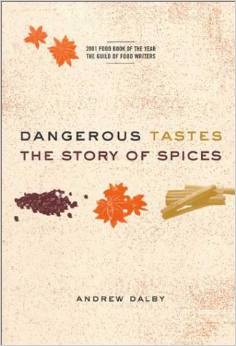Dangerous Tastes. The History of Spices. Andrew Dalby, 2000.
A fascinating little introduction to the world of spices, with a few highlights and a few letdowns.
Dalby gives an overview of the many spices that humans have used, coveted, and built transcontinental trade routes and empires over, that is far-ranging and comprehensive.
One gets to know about the historic and lost silphium of the Middle East (and ancient Rome) same as about the Sichuan pepper that is still much in use in East Asia, finds old texts and perhaps novel ideas, learns more about spices that are everywhere and spices that have disappeared.
That is nice, but also the problem.
In ranging so far and wide, many a spice that entire books could be (and have been) written about gets merely a paragraph. Through this encyclopedic approach, if a reader already knows a lot about spices, their prior knowledge is activated, or if they know less, their appetite may be whetted.
However, Dangerous Tastes tends not to read like one story, but rather like a collection of encyclopedia articles, if not nearly so dry, that sometimes (often?) seems to jump into an interesting theme only to abandon it for the next one.
That said, there are lots of insights, and a few for which Dalby is to be recommended and commended.
For one, sugar is put into its proper (historic) place as a spice, something to sweeten up special treats for special occasions, rather than the ubiquitous cheap ingredient it is now being used at. That alone is a point worth reading about and thinking about, especially if one goes on to take a look at the very recent writings on how sugar, nowadays, may be better considered a poison in our diets, in the ubiquity it has gained in modern industrial “foods.”
Dalby’s writing is particularly good, in terms of structure and specificity (though also ‘great’ in shortness), when it comes to the chilli.
There, he is one of few general authors to separate the major groups of cultivated capsicums of different origins (all within the Americas, but still somewhat separate) and to give them their specific histories, rather than lump them all together.
Where else, for example, would one find a thought-worthy discussion of the chile pepper species most likely first encountered by Columbus in the Caribbean? Who else gave rocoto, chinchi uchu and ulupica their own separate entry, as these Andean peppers should have?
But, just as he does throughout, just as he gets started, his telling is also already finished. A page or two, and that was it about the chilli, too.
Still, he is the first author I have found to not fall for the tale explaining that spices were so popular in the Middle Ages in Europe (and the chilli, in slightly later times) because the people of that time could not help getting/having rotten meat which needed spices to cover its smell, but to argue that this is most likely a tall tale put forth by some historian and then repeated by others just because it fits with modern prejudices so well.
All in all, Dangerous Tastes makes for an excellent addition to a well-stocked chilli/spice book collection, with an encyclopedic approach – for both worse and better.
Get it if you don’t have too many books on spices yet, or if you have so far focused only on one or two particular spices and would like to expand your horizons.
Just don’t expect that this is the one story of spices that will tell you everything all in one go. It is but a starting point, if a good one, for learning what else would be out there and may be of interest to you.

Leave a Reply
You must be logged in to post a comment.